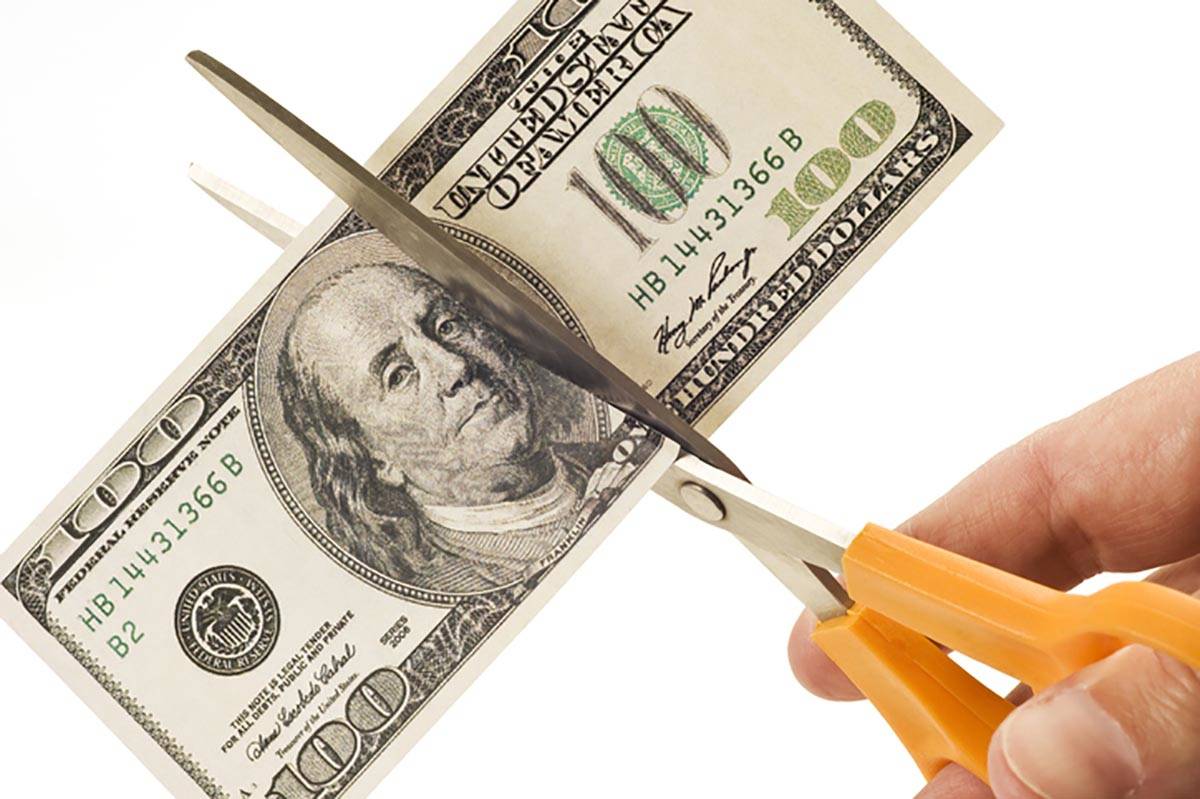Cutting these 22 expenses will save more than $15k a year
When it comes to living expenses, the truth is that most Americans subsist on a very thin margin, even if their earnings are solid. A recent survey from PYMTS revealed that 125 million American adults, including 53% of those who earn between $50,000 and $100,000, are living paycheck to paycheck. The numbers are even worse for millennials, 70% of whom are just scraping by.
Find out: How to set a realistic budget you can live with
The good news is that if you take a closer look at how you live, you’ll likely find many areas where you can trim expenses and give yourself an extra buffer.
See what expenses you could cut from your budget, how you can save thousands of dollars in the process and how you can better invest the money instead.
1. Credit card interest
Monthly Savings: $31.92
Annual Savings: $383
Every month that you don’t pay your full credit card balance you’ll be charged interest. That’s essentially money you’re throwing away. The average American has a monthly credit card balance of $4,235, according to the most recent data from the Federal Reserve. With an average annual percentage rate of 16.30% interest, many Americans can save big on fees by getting rid of their credit card debt.
Let’s assume you’ve built up the average amount of credit card debt and want to pay it off over the course of a year. By the end of that year, you’ll have paid $383 in interest, according to Credit Karma’s interest calculator.
See: I use these 3 foolproof strategies to avoid credit card debt
2. Life insurance
Monthly Savings: $20
Annual Savings: $240
Life insurance is an essential benefit for many because it provides protection for spouses and heirs in case the primary breadwinner dies unexpectedly. This can be especially important if the family has a mortgage or other debts to pay off. About the least you can expect to pay is around $20 a month for a $500,000, 10-year term policy, according to Progressive.
But if you have no dependents, you likely don’t need life insurance and might consider cancelling your policy. Another option is to look for a job with employer-paid life insurance.
3. Brokerage commissions and fees
Monthly Savings: $154.17
Annual Savings: $1,850 ($600 commission on stock trades plus $1,250 for a $25,000 investment in a load vs. no-load fund)
A few traditional, full-service brokerage firms still charge potentially hundreds of dollars per trade, depending on the size and type of investment. At Edward Jones, for example, commissions start at 2.5% of the principal amount invested or a minimum of $50. Investing $2,000 every month means spending at least $50 on fees. Mutual funds can cost even more, with commission of up to 5% when you buy.
Many well-known, reliable discount brokers like Fidelity still have brick-and-mortar branches but offer $0 commission trades on stocks and no-load mutual funds.
Also, don’t overlook annual expense ratios when buying investments like exchange-traded funds. According to the Financial Industry Regulatory Authority’s fund screener, expense ratios for S&P 500 index funds range from 0% to 2.58%.
See: The most fascinating things you never knew you could invest in
4. Bank fees
Monthly Savings: $14.50 ($12 checking plus one out-of-network $2.50 ATM fee)
Annual Savings: $174
Some banks charge $12 or more per month to maintain a checking or savings account unless you meet certain criteria, such as a minimum daily balance. But many online banks offer these accounts for free. If you prefer not to bank online, check out your local credit union, which might offer free accounts and free ATM access.
Read: How to avoid common bank fees and charges
5. Premium gas
Monthly Savings: $28
Annual Savings: $336
Unless your car specifically requires premium gasoline, you don’t need to buy it. According to AAA, the price difference between premium and regular gasoline averages 62 cents per gallon. With the average American vehicle getting roughly 24.9 miles per gallon and the average American driving 13,476 miles per year, sticking with regular gas can result in some real savings.
6. High-end coffee
Monthly Savings: $25.50
Annual Savings: $306
Face it: Some people need their morning coffee to function normally. But even if that applies to you, coffee doesn’t have to cost a fortune. You don’t even have to cut coffee out of your life completely — just reconsider if the price you’re paying now is worth it. For example, a tall (small) brewed coffee at Starbucks is $1.85, but you can go to the McDonald’s down the block and get a small cup for just $1. Assuming you buy a cup every day, that switch will save you $25.50 a month. You might even end up preferring the taste of McDonald’s coffee, making it a win-win.
Keep Reading: 35 surprising cities with low costs of living
7. Bottled water
Monthly Savings: $4.52
Annual Savings: $54.24
Annual consumption of bottled water in the U.S. reached 45.2 gallons per capita in 2020, which is a lot more expensive than drinking regular tap water. At an average cost of $1.20 per gallon of bottled water versus Baltimore’s $0.003 per gallon for municipal tap water, for example, you’re paying 400 times more for the bottled variety. Prices for different bottle sizes can be even higher.
Shop smarter: 39 supermarket buys that are a waste of money
8. Cable TV
Monthly Savings: $130
Annual Savings: $1,560
Cable television has grown from a minor utility into an expensive mishmash of multilevel packages with premium channels and content. Premium cable TV packages can cost up to $130 a month. Cutting the cord will save you money, especially if you use an antenna to pick up broadcast signals for free rather than signing up for a lot of streaming services to replace cable.
Related: Is it worth subscribing to Disney+ and other streaming services now?
9. Streaming services
Monthly Savings: $95.97
Annual Savings: $1151.64
See, streaming costs do add up. Services like Netflix and Hulu might seem like a dream come true because they’re much cheaper than cable TV packages, but they still cost something.
Netflix Premium charges $17.99 per month, Hulu with Live TV costs $64.99 per month and Amazon Prime Video is included in the $12.99 per month fee for a Prime membership. If you bundle everything together, you end up paying a lot every year for these seemingly inexpensive services. Can you imagine cutting the cord completely? You’d certainly save a lot.
Watch for less: Cut the cable cord in 2021 with 3 completely free tv apps
10. Phone games
Monthly Savings: $6.40
Annual Savings: $76.80
Many smartphone users fall into the trap of playing online or app-based games that entice them with in-game purchases. In fact, the average iPhone user spent over $76.80 per device on games in 2020, according to a Sensor Tower report. The $6.40 monthly cost might not seem like much, but it adds up over time — especially if you play on more than one device.
11. Out-of-town weddings
Annual Savings: $955 (one out-of-town wedding per year)
Attending an out-of-town wedding is no small endeavor. You must arrange travel, perhaps buy yourself a new outfit or two, purchase a wedding gift and find accommodations. Before you know it, you’ve blown a lot of money to see two people get hitched — $1,140 per guest attending an out of town wedding, on average.
Compare that to the $185 an average guest spends to attend a wedding in their own hometown. Declining just one out-of-town wedding invite per year can save you enough for a long weekend getaway of your own.
12. Satellite radio
Monthly Savings: $16.99
Annual Savings: $203.88
Satellite radio lets you listen to more than 155 channels in your car and over twice that online. The industry is known for promotional pricing, but the regular cost of a satellite radio subscription can be hefty — $16.99 per month for the Sirius XM Car + Streaming subscription, for example. With other low-cost or free options like Spotify and Pandora available, you can save cash and still access the music you want.
Learn: How to save money on all your monthly expenses and bills
13. Warehouse club memberships
Annual Savings: $60
Shopping at warehouse clubs is popular for budget-conscious families. But if you don’t have the storage space or the inclination to buy in bulk on a regular basis, your membership could wind up costing more than it’s worth. A Costco membership costs $60 a year, and a Sam’s Club membership is $45. Shop during sales at other grocery stores and save on the membership fees.
Think about it: How much does a Costco membership really save you?
14. Gym memberships
Monthly Savings: $58
Annual Savings: $696
The average gym membership costs $58 per month, but 67% of people with gym memberships never use them. If you’re among that percentage — and even if you’re not — dropping your gym membership can add up to big savings.
Stop now: 50 ways you’re throwing money away
15. Cigarettes
Weekly Savings: $50.54 (one pack per day)
Monthly Savings: $216.60
Annual Savings: $2,635.30
Smoking rates continue to decline in the U.S., with only 14% of American adults smoking, according to the Centers for Disease Control and Prevention. If you still light up regularly, here’s another reason to quit: You’ll save an average of $7.22 per pack.
Explore: 10 Ways That Your Health Impacts Your Financial Life
16. Manicures and pedicures
Monthly Savings: $35
Annual Savings: $420
While it’s fun to treat your fingers and toes to a little upgrade every now and then, those services can add up. The average manicure is about $15 a pop, while the average pedicure runs around $20. Doing your nails at home can save you quite a lot of money over the course of a year, even if you only get one mani/pedi a month.
Find out: How to set a realistic budget you can live with
17. Haircuts
Monthly Savings: $8.83
Annual Savings: $106
The national average cost of a haircut is $53, according to a survey by You Probably Need a Haircut. Let’s say you get your hair cut once every six weeks, for about eight haircuts a year. If you can stand a little shag, let your hair grow longer, get a haircut every two months and watch your bank account get bigger.
Check out: 20 ways to save money fast
18. Lunch out
Monthly Savings: $200 (for 20 lunches out)
Annual Savings: $2,400
Lunch costs range from a few dollars at a fast-food restaurant to $20 at a nice sit-down place. Let’s assume you’re spending $10 total (including tax and tip) on lunch each day. For that much money, you could probably buy the supplies to make a humble lunch for the whole week. If you saved the money you used to spend on eating out for lunch, you could afford a vacation by the end of that year.
19. Takeout food
Monthly Savings: $280
Annual Savings: $3,640
When you order takeout food instead of making it yourself, your wallet can take a big hit. The average millennial spends $70 a week on takeout, as GOBankingRates reported earlier this year. By making food at home rather than ordering in, you could save a significant chunk of change that could be spent on other necessities.
20. Ride-sharing services
Monthly Savings: $39.58
Annual Savings: $475
The two most popular ride-sharing services, Uber and Lyft, have seen significantly higher sales so far this year as the pandemic eases and more Americans venture out. But before you update your apps, consider how much you’ll spend if you go back to your old ride-share habits. The average Lyft ride cost $27 in June and the average Uber rider paid $20, according to Bloomberg Second Measure. Riders who use both services spend an average of $475 per year — a chunk of which you likely can save by walking or taking public transportation.
Explore: Best cities to retire on a budget of $1,500 a month
21. Dry cleaning
Monthly Savings: $15
Annual Savings: $180
Dry cleaning services typically charge by the item, so prices vary depending upon which items are brought in for cleaning. Many people reserve this service for hard-to-wash things like suits, slacks and dresses. The cost to dry clean a suit once a month typically runs around $20, while dresses can run around $15. Figuring a monthly spend of $15, if you can handle the work yourself, you could save almost $200 dollar a year.
22. Online shopping shipping
Monthly Savings: $10
Annual Savings: $120
Due to the pandemic, online sales increased 32.4% from 2019 to 2020, according to Digital Commerce 360. Although many online retailers offer free shipping, some stores charge a fee for orders under an order threshold of $50 to $150. At Bloomingdale’s, for example, shipping is free with purchases greater than $150. A purchase total between $50 and $75 incurs a $10 shipping fee. Those fees can really add up, even if you only shop once a month.
If you eliminated the prior things from your budget completely, you’d stand to save up to $18,000 every year. Granted, that’s probably impractical, but this exercise does show that the little things add up. Do a spending audit, and then prioritize your expenses.
More From GOBankingRates
5 things most Americans don’t know about Social Security
20 home renovations that will hurt your home’s value
What income level is considered middle class in your state?
Daria Uhlig contributed to the reporting for this article.
This article originally appeared on GOBankingRates.com: Cutting out these 24 expenses will save you over $15,000 a year






















